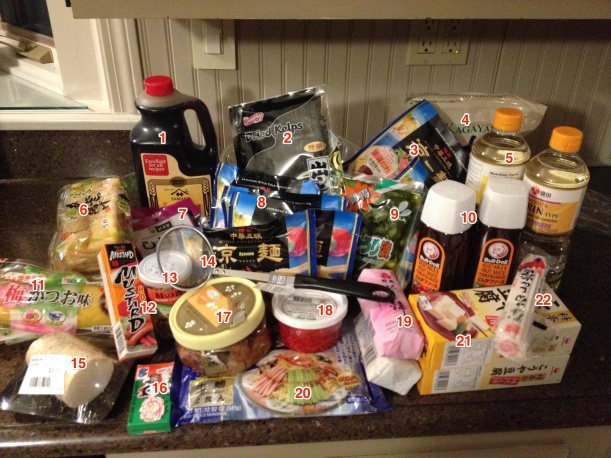Sam and I have a love for Japanese food. I don’t quite know where it all came from, but we’ve incorporated a lot of key Japanese foods into our diet, and we are always exploring new Japanese dishes. Warning flag… This is NOT a post about local foods. This is actually a post about the least local thing we eat… Nonperishables imported from Japan. Claims of locavore hypocrisy are welcome in the comments!
Sunday, Sam and I took a trip to Boston to scout out the Japanese and Asian grocery stores and came home with a mess of pantry staples. There are a lot of key pantry staples that we just can’t substitute. Maki at JustHungry has a great review of what these basic foods are and how to cook with them.

1. Yamasa soy sauce. 2. Kombu, dried kelp used in making dashi stock. 3. Hiyashi chuka noodles: Sesame vinegar dressing with hot mustard. 4. Brown sushi rice. 5. Hon mirin. Not the shitty corn syrup stuff. 6. Fried tofu pockets for making inarizushi. 7. eggplant pickles (the only way I will eat eggplant). 8. More noodles. 9. Cucumber pickles. Totally unlike all American Kosher Dills. 10. Tonkatsu sauce. 11. Takuan, pickled daikon radish. 12. Ripping hot spicy mustard. 13. Salmon Furikake. It’s a mix of sesame, nori (seaweed sheets), and dehydrated salmon that you shake on top of rice or tofu. 14. A foam skimmer. It’s a joke. I’ll explain later. 15. Yamaimo or slippery potato or mountain yam. 16. Botan rice candy. 17. Ume plums. Pickled apricots with a minty herb called shiso. 18. Beni Shoga, or pickled ginger. Unlike the stuff at sushi bars, this has no added sweetener and is a little salty. 19. Fish cake. This is pollack that is died and pressed into shapes. I serve it in noodle dishes. 20. More noodles, but this kind is fresh instead of dried. 21. Kouya dofu, or freeze-dried tofu. I’ll use it to make mochi nuggets, like vegan chicken nuggets. 22. More fish cake, but this time extruded into a log with a pink spiral shape.
We visited two different Asian groceries:
Ebisuya Japanese Market in Medford, MA.
65 Riverside Ave Medford, MA 02155
781-391-0012
info@ebisuyamarket.com
This was a Japanese-only grocery store and where we bought about 90% of our pantry staples. They had some fresh foods, but mostly shelf-stable foods. They were operating a busy fish counter and had a sushi bar attached to the grocery. The whole store was the size of a big convenience mart. I was very impressed with the selection of foods at Ebisuya. Someone with a great love of Japanese food is making sure the Japanese of Boston metro area have access to fine-quality imported foods. They even had fresh green ume plums!
H Mart
43 Middlesex Turnpike, Burlington, MA 01803
781-221-4570
H Mart is the Big Box asian grocery. Frankly, it was very intimidating to be there on a Sunday afternoon – the whole store was PACKED with customers. There was a wait for parking. H Mart is mostly Korean goods, but they carry a lot of Japanese foods as well, due to the overlap between the cuisines. We only picked up a few items there because Sam and I were both completely overwhelmed by the size and business of the store. We’ll try to go back midweek and midday and hopefully it’s not so crazy. I think we could find everything we wanted there, and the prices were about comparable to Ebisuya. H Mart does have a large produce section, if we’re wanting produce for whatever reason.
Over the next few weeks, I’ll be posting some videos and explanations of how I use a lot of these foods in my cooking.
